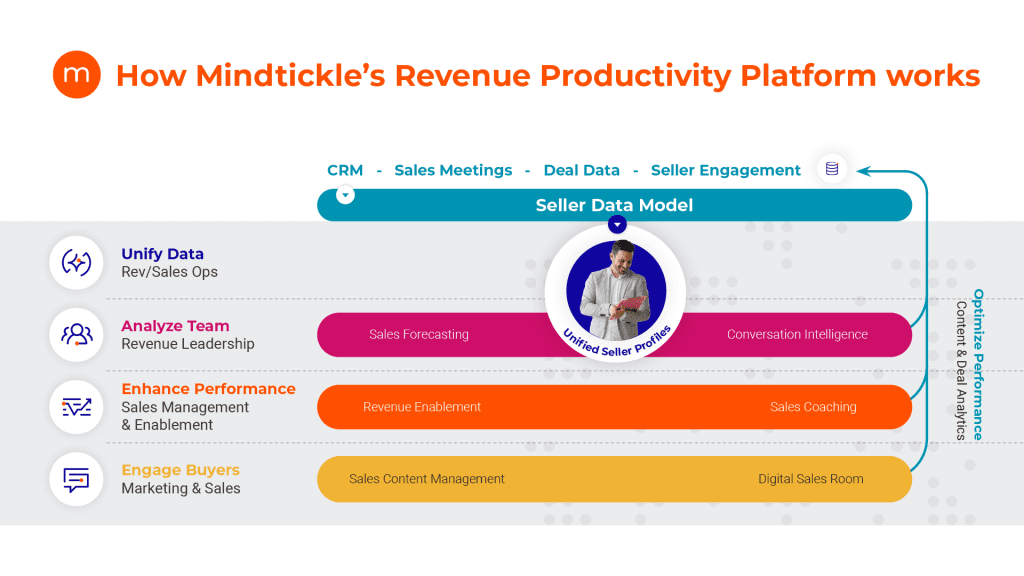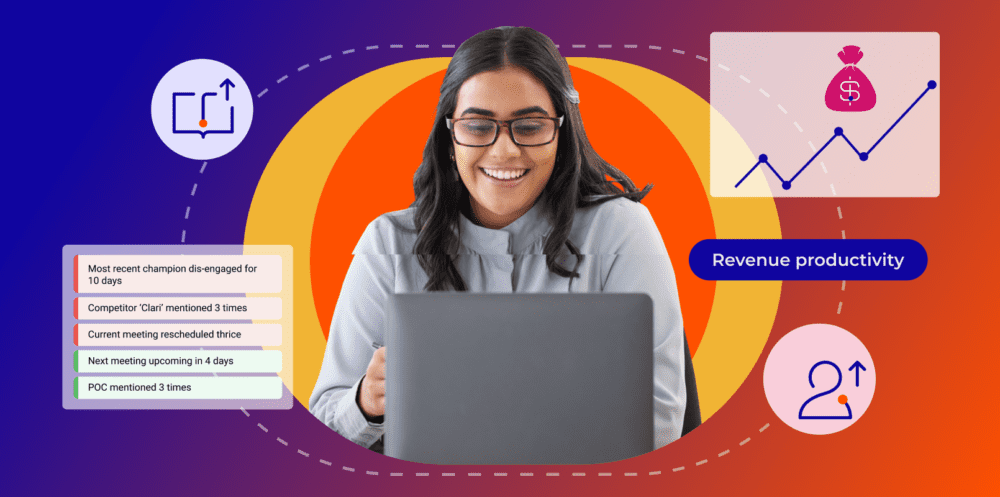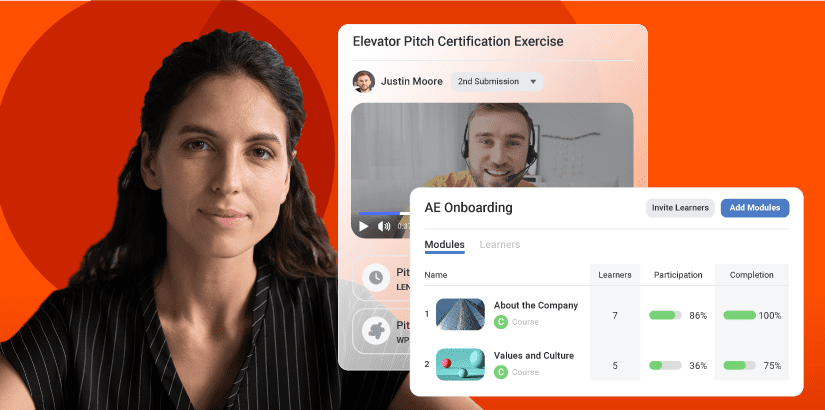What is Revenue Productivity?
Revenue productivity is a new and emerging discipline, but it can be overwhelming to understand how it fits into your organization. This post will help you make sense of it, and provide some practical areas to get started.
First, let’s start with a definition of revenue productivity:
Revenue productivity is a set of processes, strategies, and technologies used to enhance sales performance by utilizing seller data, revenue analytics, sales enablement, and front-line sales coaching.
When executed properly, revenue productivity can help organizations improve the participation rate of each seller and put more of them on a path to attain 100% of their quota. From a management and operations standpoint, it can improve the accuracy of their forecast by pulling in a more complete set of data points, combining deal information with seller behavioral data. In doing so, they can not only predict outcomes more reliably; they can remediate each of them at a team and individual rep layer faster.
Today, the emergence of revenue productivity platforms can help you bring this concept to life. Revenue productivity platforms help businesses consolidate a variety of tools surrounding their CRM system in one central place, including sales forecasting, sales training & enablement, sales content management, sales conversation intelligence, sales coaching, and digital sales rooms.
Here is a five-step process for thinking about what revenue productivity projects contain.
- Seller data unification
- Revenue analysis inclusive of deal + seller data
- Training and enablement content that’s triggered, personalized, and diversified
- Sales content management and buyer engagement
- Optimize for future performance


Seller data unification
To enhance the productivity of sellers, it’s vital to understand all the different systems in which a seller generates data. This, by the way, is not just your CRM system. While your CRM is great for tracking opportunities, closed-won data, and managing customer & prospect data, it doesn’t account for a variety of interactions your seller has with a customer. You need to collect that under a singular ID.
Here are some examples:
- Sales engagement data for email outreach, such as email opens, click rates, and replies
- Sales conversation intelligence for meeting data, culling things like topics and messages covered, time spent talking versus listening
- Sales training data, such as scores out of 100 on key certifications and courses
A revenue productivity platform should federate that data about each seller in a Unified Seller ID. From there, it can be paired with their deal and opportunity data within your CRM. This will have two benefits – mainly, better analysis for forecasting and the ability to customize training and enablement content for each rep. Read on for more information on those pieces.
Revenue analysis inclusive of deal + seller data
Once you have your data unified, a revenue productivity platform should provide you the ability to analyze that data for a more comprehensive forecast and view of org readiness. This will be a project led in large part by your revenue operations or sales operations team.
The first area is sales forecasts. Most sales forecasts today – even the ones enhanced by AI tools sitting on top of CRM – still mainly rely on deal data to provide leadership with a line of sight on performance. By injecting seller data into that forecast, you can get a more accurate picture of what business will close, and what’s at risk.
For example, if you see a deal entering negotiation phases in your forecast, if your revenue productivity platform knows the rep working that deal indexes low on negotiation because of historical sales conversation data and low training scores in negotiation, you know that deal is at greater risk of closing.
The second area is around flagging productivity issues immediately. Your revenue productivity analysis should leverage the data you have about each individual to provide managers with insight into what areas need to be remediated from a training or coaching perspective. For example, if a sales region relies heavily on reps to source their own pipeline without help from marketing, then the system should automatically alert management if reps are indexing low on qualification and discovery skills, and recommend specific training and content to address those issues.
To make this in-field analysis compelling and accurate, every revenue productivity platform should utilize a sales conversation intelligence platform to track interactions in each call with a buyer, analyzing themes, messages, and buyer reactions.
Training and enablement content that’s triggered, personalized, and diversified
Most companies today still leverage a traditional, calendar-based enablement schedule to ready their reps for in-field interactions. Everyone gets the same content and training regardless of the skill sets and knowledge they exude in-market. The challenge with this approach is that it’ll mean the majority of programs and content delivered to them will not be relevant. It shouldn’t be surprising, then, that CSO insights found less than a third of these programs meet rep expectations.
When sales enablement, training, and readiness programs are migrated into a larger revenue productivity project, companies can flip this calendar-based, generic content model on its head. Revenue productivity platforms will empower revenue leadership, revenue operations, and front-line sales managers to trigger personalized programs for each rep based on the skill strengths and gaps they show in real-world selling scenarios.
In addition, a revenue productivity platform will leverage a variety of engagement mechanics to keep these programs fresh and reinforce knowledge after it’s passed on. These engagement mechanics include things like quizzes, missions, and learning series and modules.
Sales content management and buyer engagement
Once team readiness has been addressed and people are engaging with customers in the field, revenue productivity platforms should make it easy for sellers to engage with their buyers in a personalized, compelling way.
For starters, that means having one place for sellers to easily search and access all the externally-facing content they need to serve customers, including presentations, product overviews, industry literature, thought leadership, data sheets, and other PDFs. This should be found in a sales content management module.
In addition, revenue productivity should include an avenue for buyer enablement and engagement. Digital sales rooms should provide an easy way for reps with no technical or coding experience to build customized pages for their buyer to access all the relevant content shared throughout the deal, and access call recordings between the two parties.
Optimize for future performance
After driving early success, it can be tempting to try to anecdotally repeat the process over and over. But companies that embrace revenue productivity know better. They will analyze the tools deployed throughout the sales process to better understand how they modify their sales process and the content utilized throughout the buyer journey.
The analytics from content shared and accessed via a digital sales room is a critical avenue, as well as verbal feedback from conversations tracked in sales conversation intelligence. The supporting cast of leaders in the revenue organization — such as sales enablement or readiness teams, marketing, and sales ops — should apply these learnings to improve the efficacy of their programs, processes, and content.
Getting a revenue productivity project off the ground can be daunting, but Mindtickle can help you. Click here to learn more about how you can get started on a revenue productivity transformation.




